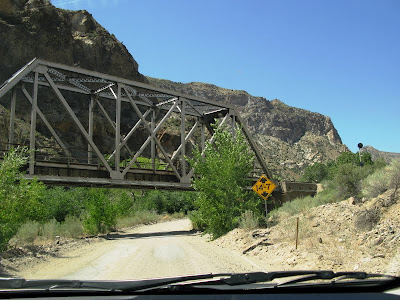
Pavement fragments from the originally two-laned road now in flood deposits on the side of the road.

A narrow part of the road in the gorge or narrows part of the canyon north of Elgin. Lower steep cliffs are in strongly welded ash-flow tuff.

Caliente camp, looking north up Rainbow Canyon.
Caliente camp - which I think I found, see this MSRMaps map location - was the site of our first base of operation in the summer of 1978. That first year - the first year of two years of helicopter-supported uranium recon - we had two camp groups of four summer geologists each, and the group I was in camped in four locations: Caliente, Deer Lodge, Hot Creek, and Bowman Creek.
The camps were helicopter camps in the sense that we used helicopters for airborne radiometric surveys and to get to our remote field locations. All camps were accessible by 4-wheel-drive. Two of our camps, Hot Creek and Bowman Creek, were along or below creeks with usable running water; two, Caliente and Deer Lodge, were not, and for those we hauled water in large tanks that fit in the back of our half-ton and 3/4-ton pickup trucks. I'd call the usable water "potable," but that implies that it was good enough for drinking without any treatment, and almost all our water was treated with the addition of chlorine bleach.
Our main jobs, as young and budding geologists, were collecting stream sediment samples, taking scintillometer readings, making sketch maps of the drainages we traversed, and mapping occasional areas of interest, over which we had staked claims. Our more detailed maps, still considered recon maps, were at a scale of 1:24,000.

The view from my tent door looked something like this - provided that I really found the right location after 30-plus years of floods.
Camp sat at the base of a 1000-foot-high cliff on an alluvial ledge perched over the flowing water of Meadow Valley Wash. Our camp equipment - tents, trucks, trailers, shower, and outhouse - were scattered amongst the cottonwood trees, facing toward the cliff and away from the paved road, the train tracks, the creek, and the opposite cliff wall, all of which were crammed into that narrow gorge. We were hidden from casual view by cottonwood and willow thickets.
I placed my tent as far away as I could from the center of camp, a center marked by a 55-gallon drum-turned-into-wood-stove, which we used for heat on chilly early mornings before the helicopter took us to the heads of various drainages. Camp was arranged in one long line, from the shower at the north end to my tent at the south. In between were L's trailer, the mess tent, a propane refrigerator, the heating drum, G’s trailer, the cook's tent, L’s tent, G’s tent, two tents for three other early-starting summer geologists, a tent for the helicopter pilot and fuel man, the helicopter, fuel truck, and our brand new 1978 Ford 4-wheel-drive pickups. The outhouse - not in the same line as the main part of camp - was up the hill a ways, amid the privacy of sagebrush and purple sage, it's open door facing toward the nearby cliff.
L and G were our two bosses, the head boss and a sub-boss of the Western District of Northern Exploration Company, NEC, a U.S. branch of a major Canadian mining company (not the real company name). L's trailer was the larger of two field trailers that we used that summer, one trailer for each of our two recon camps. At Caliente camp, we used L's trailer for cooking, storage of supplies and maps, and as a small field office. Each afternoon before dinner, we plotted sample locations, lines from our helicopter-borne radiometric surveys, and any mapping we had completed on clean, unfolded 7.5-minute topographic maps. G's trailer, the smaller of our two trailers, would be used the same way when we later split our gradually growing group into two camps.

The main road, paved and graveled, ducks under the railroad tracks where it leaves the camp area and heads north toward Caliente.
Continued at Caliente Camp: Some more Exploration and Caliente Camp Continued: Part 3, Part 4, Part 5, and others.
2 comments:
What a great spot to work. And how nice to reconnect with this gorgeous landscape. Must have been an amazing experience.
Gaelyn, because we liked to be near water, we often had great places - but not always, as you'll see if I manage to get a pic of our Deer Lodge camp. Might get some more pics of this camp and area soon!
Post a Comment